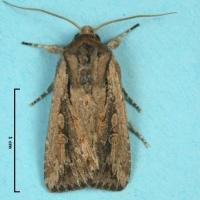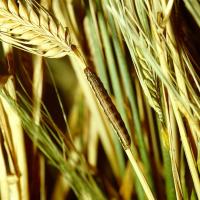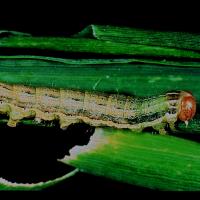Diagnosing armyworm
When barley crops are maturing in spring, large armyworm caterpillars climb plants and can chew through the stems causing the heads to fall to the ground. Damage to wheat and oat crops occurs less frequently and is usually minor compared to damage in barley. Armyworms are seldom a serious problem in pastures.
What to look for
- Patches within cereal crops (especially barley) with insect chewing damage.
Paddock
- Large armyworm caterpillars can climb up plants and chew through the stem of barley just below the head causing the heads to fall to the ground. Extensive damage can occur with a short period of time (days). Chewing damage will also be seen to leaves and party eaten grains on the heads.
- In wheat crops isolated patches of the crop can be found with chewed leaves, awns and grains on the seed heads damaged. In oat crops, larvae bite off pieces of the panicle, causing grain to fall.
- Armyworm can be found during the day on plants but are usually unseen as they prefer to shelter during the day and feed mostly at night. Armyworm caterpillars can often be found hiding under the inter-row leaf litter within patches of crop where damage is seen. Caterpillar droppings resemble small 'green' bales of hay and can often be seen on the ground below the crop canopy.
Plant
- Moths have stout bodies pale to cream in colour with a wing span of 40 millimetres (mm), they fly at night and some armyworm species are strongly attracted to lights.
Insect Adult
- Armyworm caterpillars vary in colour depending on their species and numbers within crops. They can be distinguished from other caterpillars by their large head and three prominent white stripes on the 'collar' behind the head. They have smooth bodies with a sparse covering of fine hairs.
Insect Larvae
What else could it be
| Condition | Similarities | Differences |
|---|---|---|
|
Helicoverpa puntifera (related to native budworm)
|
The caterpillars have the same striped appearance | The native budworm type caterpillars have rough skin that is sparsely covered with bumps and bristles and they very rarely will chew stems through to lop heads |
| Diagnosing cutworm in cereals | Chewing damage to plants but cutworm damage occurs mainly at the plant seedling growth stage | Armyworm caterpillars have larger heads and three prominent stripes on the collar behind the head |
Where did it come from?

Green bridge
- Occasionally armyworm moths move in large flights in search of food, but usually damaging populations breed within localised areas.
- On the south coast of Western Australia armyworms have 3-4 generations per year and can survive the summer on self-sown cereals and grasses that germinate with summer rains.
- During spring it can take as little as 3 weeks for larvae to reach a damaging size after eggs are laid.
Management strategies

Green bridge control

Beneficial insects

Spraying insecticide
- Destroy weedy paddocks several weeks before sowing pasture or crop. This will reduce the feed source for insects.
- Heatwaves may reduce armyworm caterpillar numbers.
- Native parasites can control armyworm biologically so spraying every year is not normally required.
- Spray application to damaging levels of armyworm maybe needed close to crop ripening. Spray withholding periods need to be observed. Increased spray volumes or chemical rates may be required in high-yielding bulky crops.
Economic and financial considerations
To assist in assessing the economic risk and financial costs associated with various treatment strategies go to MyEconomicTool
There may be other economic and financial implications that need to be considered when choosing a management option. These may include:
Pre-crop- Understand the potential yield losses associated with armyworm feeding damage.
- Assess the costs and benefits of taking preventative action to directly control armyworm.
- Assess the cost and benefits of controlling summer weeds to reduce feed source of armyworm.
- Compare the costs, benefits and risks of each management option against doing nothing.
- Consider risk and associated costs or savings of no treatment or delaying treatment.
- Consider the potential risk of re-infection and costs of further treatment.
- Ignore all previous treatment costs in assessing current management options.
- Undertake a ‘what if’ scenario analysis to see what impact changing variables (e.g. grain price and seasonal conditions) have on the net income.
- Consider using an integrated pest management system and include a resistance management strategy into your spray program.
View these economic considerations in more detail.
How can it be monitored?
- Look for chewing damage to leaves, stems and heads and signs of caterpillar droppings on the ground.
- Look for damage to crop foliage.
- Look for caterpillars on the plants, on the ground and searching the leaf litter between rows.
- If caterpillars are present, check frequently for the first signs of head-lopping in barley.
See also
Page last updated: Friday, 17 April 2015 - 2:14pm




